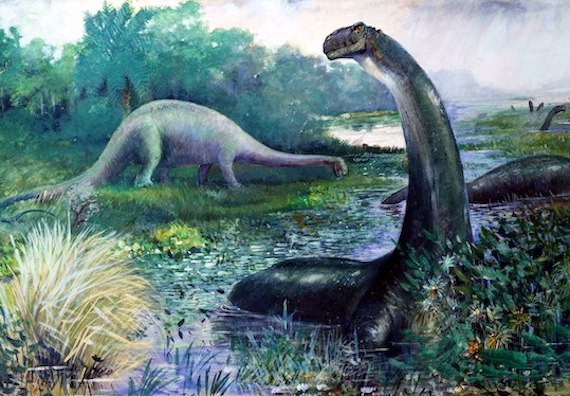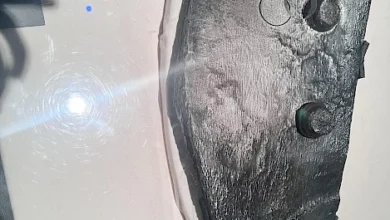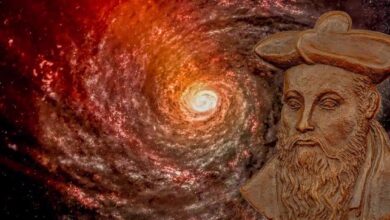Strange and Harrowing Encounters With Explorers Firing on Mystery Monsters in the Jungles of South America

Explorers have long come back from the fringes of our world and the dark spots on our maps with amazing tales of strange creatures lurking out beyond the bounds of civilization and what we think we know. Out there in the uncharted wilds there are allegedly all manner of strange beasts out past our understanding, and those who would delve into these strange new realms have loing brought back tales to make us wonder. Some of the most amazing of these involve harrowing incidents in which these explorers have actually fired at and even killed these creatures, and here we will look at a selection of some of the most intriguing.
A rather early account of explorers firing upon a cryptid in the jungles of the Amazon comes to us from 1883, when it seems a dinosaur of some sort was shot and killed on the Río Beni, in the El Beni Department of Bolivia. According to an article on the matter in Scientific American, the creature was some kind of bizarre, long-necked dinosaurian monster, and explorers purportedly shot it 36 times before supposedly preserving its body and sending it off to La Paz to be studied, while drawings of the animal were said to have been sent to the Minister of Foreign Affairs in Brazil from the Brazilian Minister at La Paz. The report describes the truly outlandish creature as follows:
It is twelve meters long from snout to point of the tail, which latter is flattened. Besides the anterior head, it has, four meters behind, two small but completely formed heads(?) rising from the back. All three have much resemblance to the head of a dog. The legs are short, and end in formidable claws. The legs, belly, and lower part of the throat appear defended by a kind of scale armor, and all the back is protected by a still thicker and double cuirass, starting from behind the ears of the anterior head, and continuing to the tail. The neck is long, and the belly large and almost dragging on the ground.

The mention of multiple heads makes this report particularly bizarre, and one wonders what this could possibly have been. Amazingly, the carcass was supposedly looked at by a Professor Gilveti, who believed it to be “a member of a rare or almost lost species, as the Indians in some parts of Bolivia use small earthen vases of identical shape, and probably copied from nature.” It is unknown what happened to the alleged body after this, and the lack of evidence, the fact that the source was anonymous, and the sheer outlandish appearance of the beast make the story somewhat suspect. It is very likely this was a completely fabricated account, but it does make one wonder.
A fairly dramatic and more detailed report comes from October of 1907, when the German explorer Franz Herrmann Schmidt and a Captain Rudolph Pfleng were on an expedition deep in the dim mosquito infested swamps of Peru. While slogging through the thick undergrowth they allegedly came across enormous, reptilian tracks like nothing they had ever seen, and not long after this the jungle erupted into the sound of shrieking monkeys, before silence descended upon them. Schmidt would write of what happened next:
For a full ten minutes there was silence, then the green growth began to stir again, and coming back to the lake we beheld the frightful monster that I shall now describe. The head appeared over bushes ten feet tall. It was about the size of a beer keg and was shaped like that of a tapir, as if the snout was used for pulling things or taking hold of them. The eyes were small and dull and set in like those of an alligator. Despite the half dried mud we could see that the neck, which was very snakelike, only thicker in proportion, as rough knotted like an alligator’s sides rather than his back. Evidently the animal saw nothing odd in us, if he noticed us, and advanced till he was not more than one hundred and fifty feet away. We could see part of the body, which I should judge to have been eight or nine feet thick at the shoulders, if that word may be used, since there were no fore legs, only some great, heavy clawed flippers. The surface was like that of the neck. For a wonder the Indians did not bolt, but they seemed fascinated.
As far as I was concerned, I would have waited a little longer, but Pfleng threw up his rifle and let drive at the head. I am sure that he struck between the eyes and that the bullet must have struck something bony, horny or very tough, for it cut twigs from a tree higher up and further on after it glanced. I shot as Pfleng shot again and aimed for the base of the neck. The animal had remained perfectly still till now. It dropped its nose to the spot at which I had aimed and seemed to bite at it, but there was no blood or any sign of real hurt. As quickly as we could fire we pumped seven shots into it, and I believe all struck. They seemed to annoy the creature but not to work any injury. Suddenly it plunged forward in a silly, clumsy fashion. The Indians nearly upset the dugout getting away, and both Pfleng and I missed the sight as it entered the water. I was very anxious to see its hind legs, if it had any. I looked again only in time to see the last of it leave the land—a heavy blunt tail with rough horny lumps. The head was visible still, though the body was hidden by the splash.
From this instant’s opportunity I should say that the creature was thirty-five feet long, with at least twelve of this devoted to head and neck. In three seconds there was nothing to be seen except the waves of the muddy water, the movements of the waterside growth and a monkey with its hind parts useless hauling himself up a tree top. As the Indians paddled frantically away I put a bullet through the poor thing to let it out of its misery. We had not gone a hundred yards before Pfleng called to me and pointed to the right. Above the water an eighth of a mile away appeared the head and neck of the monster. It must have dived and gone right under us. After a few seconds’ gaze it began to swim toward us, and as our bullets seemed to have no effect we took to flight in earnest. Losing sight of it behind an island, we did not pick it up again and were just as well pleased.
What was going on here? In 1921, a Brazilian Indian named Alvaro Mesquita supposedly came across a dinosaur-like beast on the shore of a swampy lake between the Rio Purús and the Rio Juruá. He apparently fired at it with his rifle and the creature disappeared into the jungle. He would later be shown pictures of various dinosaurs and claim that what he had seen resembled a Camptosaurus, a type of a genus of plant-eating, beaked ornithischian dinosaurs of the Late Jurassic period. The report is brief and lacks detail, so it is hard to know what to think. A similarly undetailed account from 1931 was by Swedish explorer Harald Westin, who described coming across a 20-foot-long reptilian beast “with an alligator-like head, four lizard-like feet, small, scarlet eyes, and a distended body.” The creature was apparently just minding its own business, but Westin apparently shot at it, only to find that his bullets had no noticeable effect on it at all and it ambled off as if nothing had happened.

One of the most well-known explorers of the Amazon jungle is the famed explorer Percy Fawcett, who is most famous for his ambitious and ill-fated expedition in 1925 to find a lost city he was convinced existed in the forgotten, unexplored depths of the Amazon jungle, a journey during which he would vanish off the face of the earth to become one of the most baffling disappearances in history. Throughout his journeys, Fawcett kept rather detailed journals of his expeditions, and flipping through the normal, more mundane everyday trials and tribulations of the expedition, one can at times find some rather amazing, bizarre accounts involving myriad strange creatures that just seem to jump off the page. Indeed, Fawcett’s journals hold a veritable zoo of strange and bizarre beasts that have never really been identified or explained. One of these is his expedition’s supposed encounters with a giant snake far larger than anything known, and also apparently more aggressive. Fawcett in this case goes into great detail about the team’s harrowing encounter with the serpent, writing:
We were drifting easily along in the sluggish current not far below the confluence of the Rio Negro when almost under the bow of the boat there appeared a triangular head and several feet of undulating body. It was a giant anaconda. I sprang for my rifle as the creature began to make its way up the bank, and hardly waiting to aim smashed a .44 soft-nosed bullet into its spine, ten feet below the wicked head. At once there was a flurry of foam, and several heavy thumps against the boat’s keel, shaking us as though we had run on a snag. With great difficulty I persuaded the Indian crew to turn in shore-wards. They were so frightened that the whites showed all round their popping eyes, and in the moment of firing I had heard their terrified voices begging me not to shoot lest the monster destroy the boat and kill everyone on board, for not only do these creatures attack boats when injured, but also there is great danger from their mates.
We stepped ashore and approached the reptile with caution. It was out of action, but shivers ran up and down the body like puffs of wind on a mountain tarn. As far as it was possible to measure, a length of 45 feet lay out of the water, and 17 feet in it, making a total length of 62 feet. Its body was not thick for such a colossal length-not more than 12 inches in diameter -but it had probably been long without food. I tried to cut a piece out of the skin, but the beast was by no means dead and the sudden upheavals rather scared us. A penetrating foetid odour emanated from the snake, probably its breath, which is believed to have a stupefying effect, first attracting and later paralysing its prey. Everything about this snake was repulsive. Such large specimens as this may not be common, but the trails in the swamps reach a width of six feet and support the statements of Indians and rubber pickers that the anaconda sometimes reaches an incredible size, altogether dwarfing the one shot by me. The Brazilian Boundary Commission told me of one killed in the Rio Paraguay exceeding 80 feet in length!
That is certainly a really big snake, far beyond the size of anything known. Again, this is an isolated report in his journal, leaving the reader to decide what ever became of it. In the end, we are left to wonder what became of any of these. It all goes to show that there are unexplored nooks and cracks of our world remaining beyond our gaze, with perhaps bizarre beasts ambling about through the shadows.




